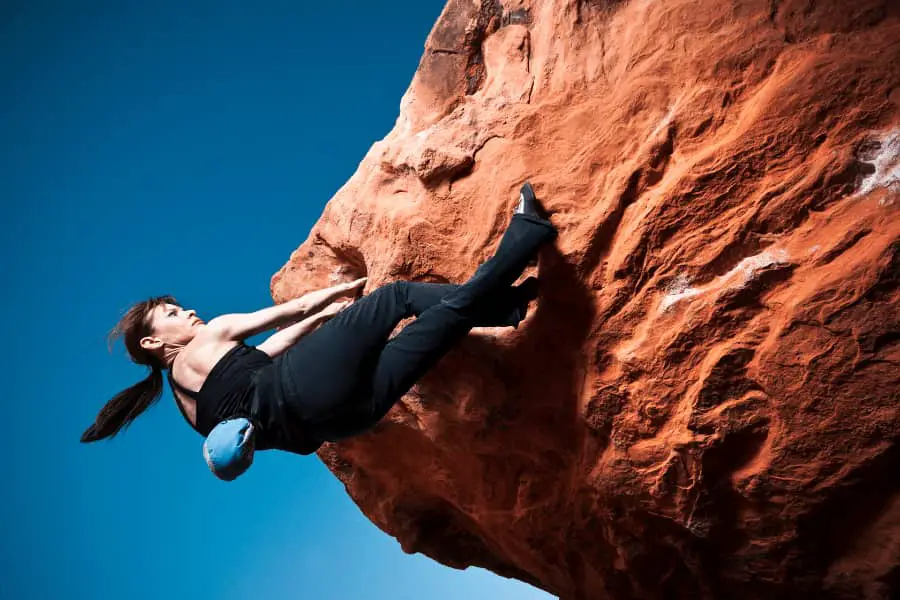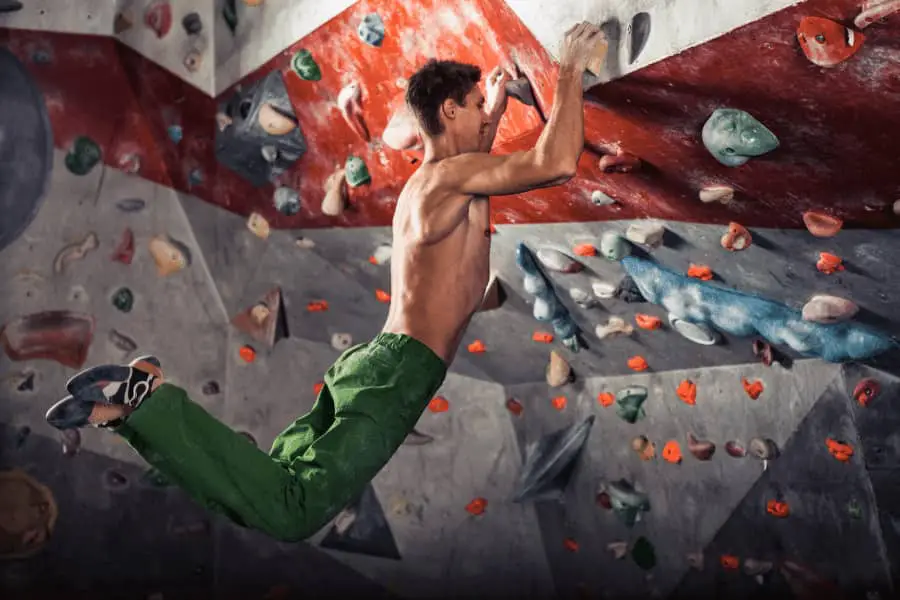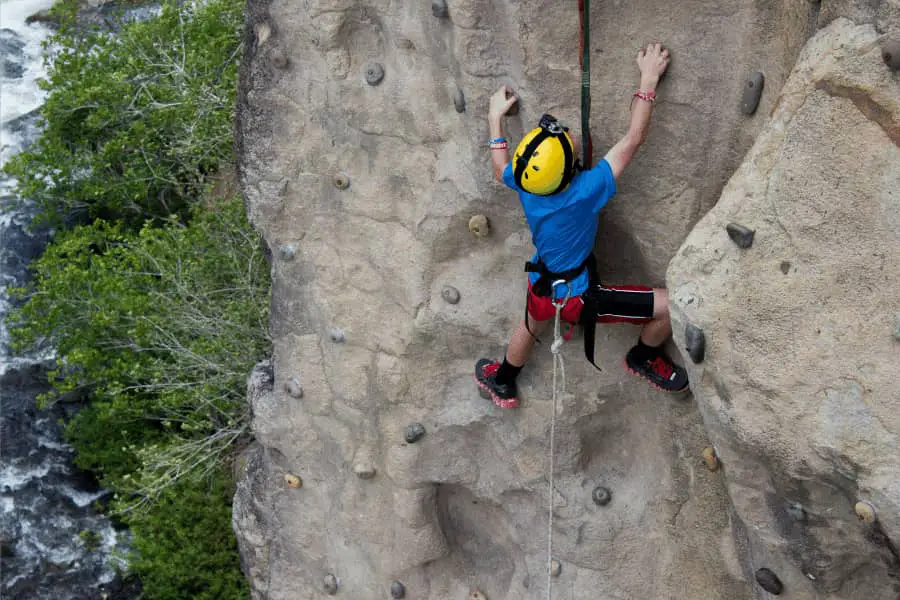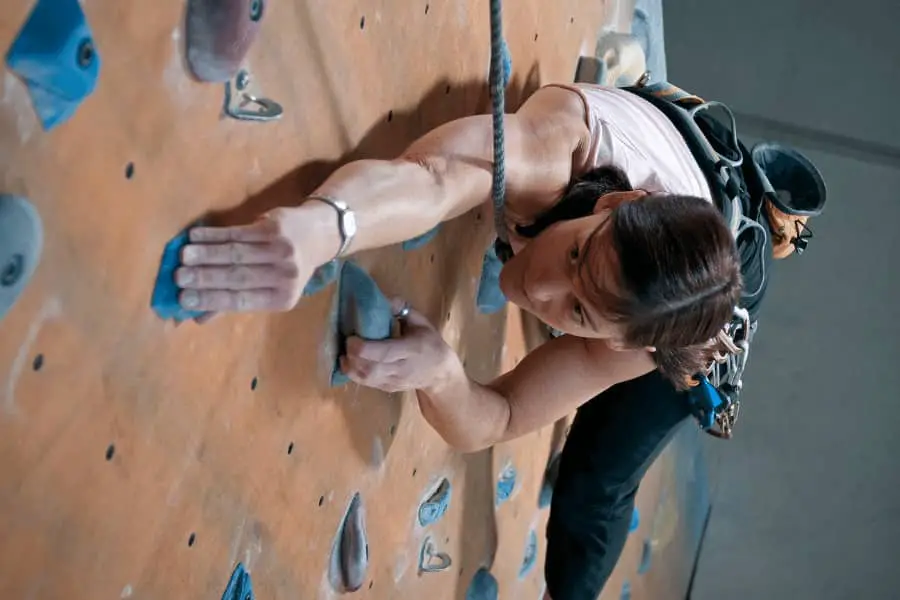
As you probably have noticed, some routes are easier for taller climbers than shorter ones. If you are a shorter climber you have no doubt struggled on routes with big moves that seem like they were set by giants. I scoured the internet and spent hours researching the best advice for shorter climbers.
Here are my top 12 tips to help shorter climbers climb harder:
- Get as close to the wall as possible
- Turn sideways when reaching for higher holds
- Practice on improving your dynamic movements
- Use higher foot holds
- Get creative with your beta
- Learn how to smear effectively
- Improve your footwork
- Work on your flexibility
- Increase your finger and grip strength
- Develop better balance
- Increase you lock-off strength
- Become a pull-up master
The sections below detail why these tips are great and lay out the best way to go about implementing them. I promise that if you are able to incorporate all of these tips into your climbing you will improve drastically.
If you are interested in seeing what the current prices are for the most popular rock climbing training aids, you can find them on Amazon by clicking here. Using the Amazon affiliate link above and/or other links in the article helps support this website.
1. Get As Close To The Wall As Possible
Getting as close to the wall as possible is probably the most important tip. If you only learn one thing from this article, this should be it. Getting as close to the wall as possible is not only going to allow you to reach higher holds but it will allow you to take some of the pressure off of your arms when climbing.
By getting closer to the wall, you improve your reach an unbelievable amount. Think of it like a triangle. Your arm is the hypotenuse, the wall is one of the legs, and the distance between your shoulder and the wall is the other leg. By shortening the distance between your shoulder and the wall, you reduce the needed hypotenuse length (arm length). In other words, you are able to reach farther.
Not only will staying close to the wall help your reach higher holds, it will help take some of the weight off of your arms. By bringing your center of gravity closer to the wall, you will reduce the amount of strength needed to hold yourself into the wall. This makes it easier on your arms and allows your legs to carry more of the weight.
To get closer to the wall you can practice turning sideways and using good footwork. To learn more about this, check out tips 2 and 7 below.
2. Turn Sideways When Reaching For Higher Holds
Turning sideways effectively will allow you to reach higher holds than normal. This happens because you are maximizing your reaching distance by getting your one arm as close to the wall as possible.
To do this, turn on the wall so that your outer hip is pressed up against it. The majority of your weight should be supported by your leg directly attached to that hip. When you go to reach for the hold, stand up on that leg and reach with the arm closest to the wall. This will provide you with the most static reaching distance possible.
Note: you may still be too short to reach certain holds even by maximizing your reach. This is okay and somewhat expected. To account for this you can practice on improving your dynamic movements as detailed in the next tip.
3. Practice on Improving Your Dynamic Movements
Climbing moves are broken into two categories: static and dynamic. Static moves are where the climber relatively stays in the same position and reaches for the next foot or hand hold. After getting to the hold, they are able to complete the move and go to the next hold. Static climbing is slow, controlled, and deliberate.
Dynamic climbing involves making a move to the next hold before coming into contact with it. Dynamic moves are beneficial for short climbers to master because not only do they look really cool but they allow climbers to reach holds they wouldn’t be able to statically. Shorter climbers will need to incorporate dynamic movements earlier in their climbing journey than taller climbers.

Two popular types of dynamic movements are dynos and deadpoints. Dynos are flashy and incredibly fun to do. They involve a complete airborne jump to the next hold. To learn how to become a dyno-master check out the article I wrote here after you have finished learning about all 12 tips.
Deadpoints are similar to dynos but just not as cool. Deadpoints involve swinging/propelling yourself to create momentum when moving to the next hold while maintaining contact with the wall. This is different from static movements as if you don’t reach the next hold, you will certainly be flinging yourself off the route.
Deadpoints and dynos increase the amount of distance you are able to cover but make it more difficult to grab onto the next hold. You will need to focus on building your core, finger, and grip strength to pull these off consistently. Further information on this is provided in tips 9 and 10.
4. Use Higher Footholds
Using higher footholds is another great way to increase your climbing ability and reach. When climbing you will want to use your legs to push yourself up the wall rather than use your arms to pull yourself up. This is because your legs are much stronger than your arms and will allow you to climb harder for longer. Using high footholds allows you to push yourself up higher on the wall and reach holds you wouldn’t be able to if you were relying on lower foot holds.
Getting your feet as high as possible when you’re short will help you consistently climb routes that you were unable to before. It will take some getting used to but with enough practice should start to feel more natural. You will able to reach higher footholds by staying close to the wall.
To use these higher footholds effectively, you will need to increase your flexibility. I talk about my favorite ways to do this in tip 8 below.
5. Learn How To Smear Effectively
Smearing is one of the most useful techniques shorter climbers can use when climbing. Smearing is the act of placing the inside of your foot against the wall. This foot will not be on any foothold, just the wall.
Smearing allows climbers to get better balance and brace themselves in situations where footholds aren’t available. Although you will not be able to push off of the wall with any significant amount of force, the little bit of weight you are able to support with a smear can make all the difference.
You can reduce the need to smear by keeping high feet as mentioned above. Certain situations will call for a smear if you are not able to get your foot up high enough. Shorter climbers will be able to use this technique to extend out and reach for farther holds without needing additional footholds.
6. Improve Your Footwork
Getting better footwork is important for climbers at any height. It is even more important for shorter climbers though. Having good footwork will allow you to keep most of the weight on your feet and allow you to keep your body closer to the wall.
Practice placing the inside and outside of your feet on the holds instead of the front of your toes. Using the front of your toes will push you out a few inches from the wall causing you to hold more weight with your arms. By turning your leg sideways and pointing your toes parallel to the wall, you are able to bring your body closer to the wall.

As discussed above, smearing is one of the most important techniques for short climbers to learn. Another important footwork technique is edging. Edging involves turning your foot outwards as shown in the picture above. To edge properly, you will place the inside edge of your shoe on the hold near the ball of your foot and big toe. This will allow you to get grip on incredibly tiny footholds.
On holds large enough, you are able to match your feet (put both feet on the same hold). This will allow you to be in a stable position and can be used to perform explosive dynamic movements such as dynos.
When holds aren’t big enough to match your feet, you can switch your feet (transition from one foot on the hold to the other foot on the same hold). Switching your feet can provide you with a better body position and will allow you to make the next move with ease.
7. Work On Your Flexibility
As mentioned previously, being able to get your feet up as high as possible is a necessity when you’re short. The best way to get better at this is to work on your flexibility.
I like to approach improving my flexibility in two different ways. One way is static stretching and the other is dynamic stretching. I split them up in these two categories and I recommend you do the same. Climbing is a combination of both static and dynamic movements. It is important to loosen up and stretch out your muscles for both of these types.
I like to do a total of about 5-10 minutes of stretching before every serious session that will use high footholds. Make sure that your are properly warmed up before deeply stretching otherwise you could pull something.
After my brief warm up, I will spend a few minutes statically stretching out my calves, hamstrings, quads, hips and lower back. Any static stretch you would like to perform is fine as long as it targets those specific muscle groups. After statically stretching out for a few minutes I will perform a few dynamic movements to get my body ready for the climbing to come.
If traditional stretching is boring for you then I highly recommend doing some yoga! Either finding a class, doing it with friends, or using a phone app are great ways to go. You can never go wrong with some yoga.
8. Increase Your Finger And Grip Strength
It is important to be strong enough to grab onto the holds when performing dynamic moves. Dynamic movements will make it harder for you to grab the next hold because you will have to catch your momentum as well.
I recommend climbing crimp and pinch heavy routes to help improve your grip and finger strength. This will help you grab onto and stay onto the holds when performing dynamic movements.

If you wish to try and get stronger quicker, you can start using a hang board. Hang boards help improve your finger strength a ton but should only be used when you are already decently strong. Most hang boards are designed for climbers with some climbing experience and are not meant for beginners.
For beginners, your finger and grip strength will be making huge improvements by just climbing more. By using crimp and pinch heavy routes you will already be speeding up that process.
9. Develop Better Balance
Balance is involved in almost every climbing move you perform. Developing better balance will allow you to extend out further when reaching and will help you perform harder moves when climbing.
To increase your balance, you will need to strengthen your core. Although your core will be strengthened by just climbing more, you can do specific exercises to get stronger quicker.
I recommend doing a short 5-10 minute session of ab work after every climbing session. Some of my favorite exercises include planks, leg raises, sit-ups and bicycle kicks. If you are not used to training your abs directly, I definitely recommend starting out slow and working your way up.
10. Increase Your Lock-Off Strength
Locking off involves holding yourself up with one arm in a bent position and reaching for the next hold with your free hand. Locking off requires a lot of back strength and is not an easy technique to pull off. That being said, it can help you reach a ton of holds that you couldn’t any other way.
The best way to get better at locking off is to practice pulling yourself up with one arm and holding yourself in the locked off position until you can’t anymore. Rinse and repeat after taking a short rest. The further you are able to hold yourself up (lock-off), the higher you will be able to reach.
11. Become A Pull-up Master
Although you are supposed to use your legs as the main way of getting up the wall, you will need to pull with your arms as well. Dynamic movements specifically rely on being able to pull yourself and push with your legs at the same time. The stronger you are at pulling, the further you will be able to go. Pull-ups are the best way to get stronger at pulling movements.
This tip will also help you with your lock-off strength. Pull-ups work the same muscles that locking off does. Talk about a double whammy.
If you are not strong enough to do pull-ups yet, don’t worry about it – there are other options. You can perform assisted pull-ups by attaching a resistance band to a pull-up bar and stepping on it with your feet. This will help push you up when you are performing the reps. Thicker resistance bands will provide more assistance.
If you do not have access to a resistance band, I recommend doing “negative reps”. Negative reps involve doing a pull-up backwards. You will start at the top of the rep with your arms in a bent position (hold this position as long as you can) and then slowly lower yourself. You can do these on jugs or on a pull-up bar.
12. Get Creative With Your Beta
Even with perfect climbing technique and incredible strength, there may be some moves that shorter climbers just aren’t able to perform. To address this you should learn how to get creative with your beta. There will always be more than one way to climb a route. Certain moves will be easier for shorter climbers to perform than trying to follow what the taller climbers were able to do.
The best way to practice getting creative with your beta is to try climbing the same route multiple times but in a different way each time. This will open up your mind and body to the different approaches you can take to problems. In addition to this, you should watch other short climbers and see how they go about climbing routes that you were struggling with.
Coming up with games to try out new beta can be fun and a very productive way to spend a few gym sessions. My friends and I would play HORSE with climbing beta. We would take turns coming up with fun and unique betas and whoever couldn’t complete it would get a letter. First person to get HORSE loses.
The bottom line? If you are able to practice the 12 tips listed out above you will notice a drastic improvement in your climbing ability. The holds that felt impossible to reach before will now be within your grasp. Go show those giants how its done!
